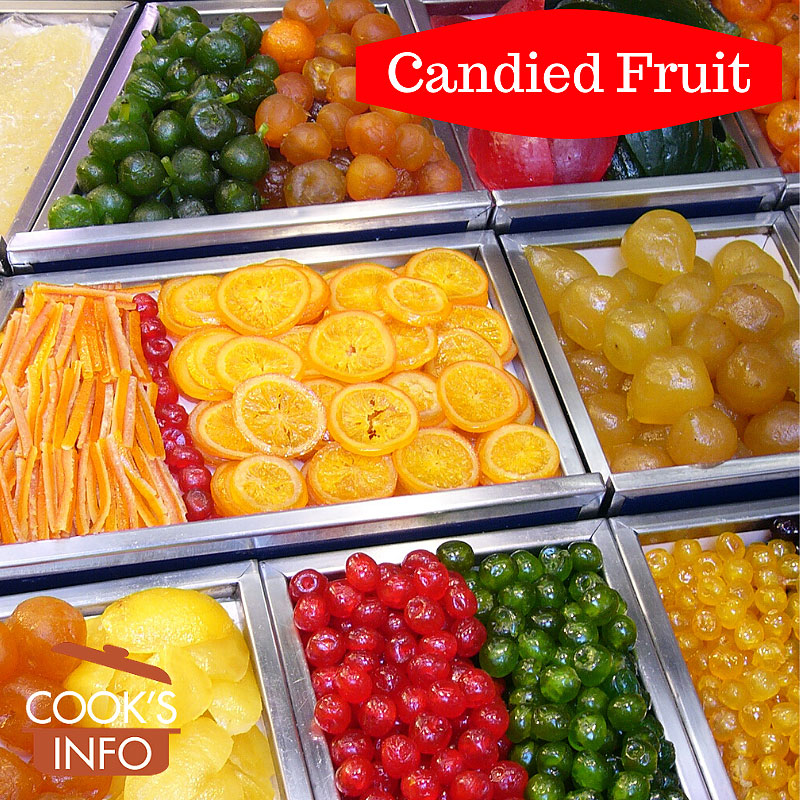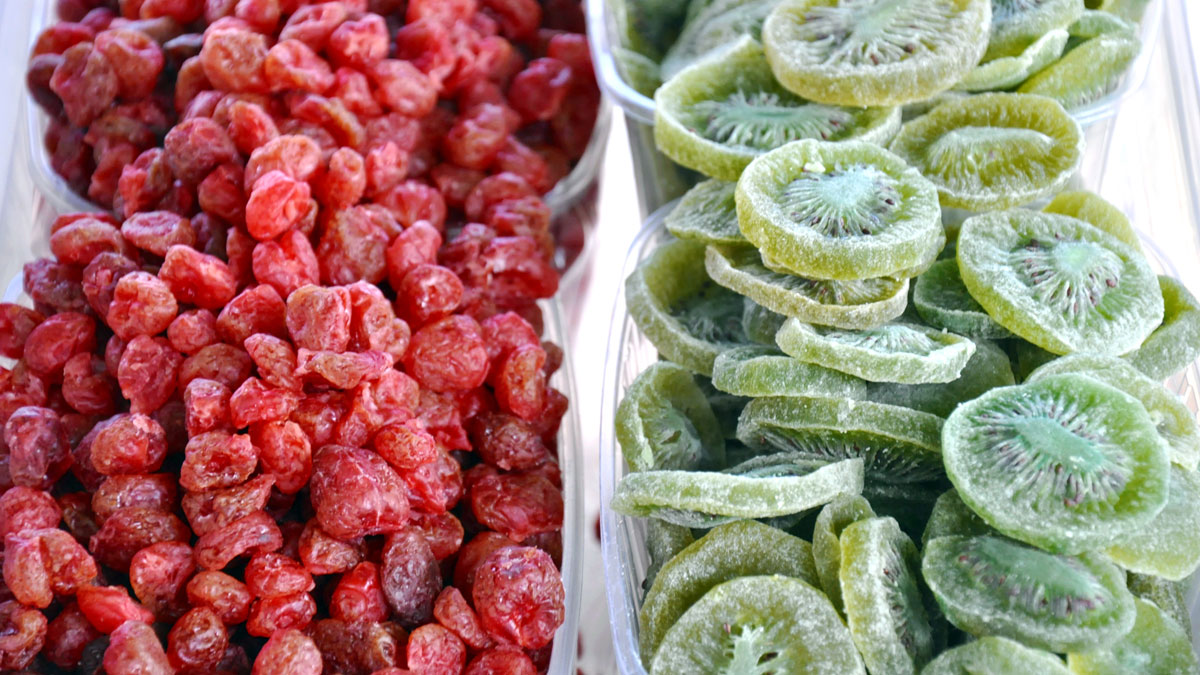
Candied fruit, “La Boquería” market in Barcelona. wikimedia / 2008 / Public Domain
Candied fruit is fruit that has been candied by drawing cell water out of the fruit and replacing that water by sugar.
The “great” candied fruits are figs, mandarin oranges, melons, pears, plums and pineapple. The French call these candied fruits the “fruits nobles”. The bulk of the industry, however, is candied cherries.
Candied fruit is sold in tubs and sealed boxes, mixed or as separate fruits.
In France, candied fruit is considered a culinary art and a great delicacy.

Assorted candied fruits in the Boyer à Sault store in Vauluse, France. Véronique Pagnier / wikimedia / 2010 / Public Domain
Making candied fruit
In making candied fruit, it is better to use fruit that is just ripe. Dried fruit can also be used. Starting from dried fruit takes two-thirds less time, but it does need to be rehydrated first. The candying process can take 6 to 14 days, or even several months. You put whole small fruits, or chopped larger fruits, into a sugar syrup, and gradually day by day increase the strength of the sugar syrup. The sugar syrup pulls the water out of the cells in the fruit, because sugar attracts water, and the water that leaves the cells gets replaced by the sugar. The process must be gradual or the fruit will shrivel and toughen.
Limes cannot be candied successfully at home; an enzyme in their rind will darken them and break them down. Commercially, though, it can be done, and both candied lime slices and candied lime peel (or zest) are available.
Candied fruit as a “catch-all” term
The term “candied fruit” is often used casually as a catch-all phrase for candied fruit, crystallized fruit (aka frosted fruit), and glazed fruit (aka glacé fruit).
Candied fruit is fruit that has been candied as described above. The two latter are actually different products. Crystallized fruit is fruit that has been frosted with caster sugar. Glazed fruit is fruit that has been coated or shipped in a sugar syrup.
Sometimes small fruit jellies made with fruit juice are also labelled as being candied fruit, but this is usually an error made by an amateur in the field. These are properly just candy that happens to be fruit-flavoured.
Cooking Tips
When dicing candied fruit, scissors can be used for a change of pace. Or the fruit can also simply be purchased already diced.
Using a food processor to chop candied fruit can be tricky. The candied fruit can often jam up around the blade. If your recipe calls for a dry ingredient such as flour or sugar, and it is appropriate to have that mixed with the candied fruit, you could try adding a small amount of the flour or sugar to the food processor along with the fruit.
Should you have fruit frosted in sugar (crystallized fruit) that you want to use in a recipe that calls for plain candied fruit, you could rinse the sugar off. It seems like a bite of a waste, however, and it may be better just to purchase plain candied fruit.
Substitutes
Other candied fruit. Not dried fruit. If you want or need to use dried fruit, look for a fruitcake recipe which calls for it. The recipe will likely have additional liquids or steps in it to compensate for the fruit being dried. Do not substitute maraschino cherries for candied cherries.

Candied fruit. Jenő Szabó / Pixabay.com / 2015 / CC0 1.0
Literature & Lore
“Candied, Crystallized and Glacé Fruits. All three types of preserved fruits are based on the same basic method of preparation and the difference is in the finish. Candied fruits are dry and they are often given a crystalized or glacé finish. A crystallized finish is achieved by rolling the fruit in sugar and a glacé finish is produced by coating the preserved fruit in a fresh syrup which is then carefully dried……
The fruit is covered with a diluted hot syrup, which is gradually increased in sugar content on a daily basis until it becomes a heavy syrup. In this way, the fruit is slowly impregnated with sugar which acts as a preservative. It is recommended that glucose or dextrose is used in place of part of the sugar, particularly when preparing candied peel.
It is essential that the process of slowly increasing the concentration of sugar in the syrup is followed as this allows the water which is present in the fruit to diffuse out slowly as the sugar penetrates it. Unless the process is gradual the fruit will become shrivelled in appearance and tough in texture.” [1]Jones, Bridget, Ed. Home Preservation of Fruits and Vegetables. London: AFRC Institute of Food Research. 1989. 14th edition, revised. Page 130.
Language Notes
Candied fruit is occasionally also referred to as semi-dried, or semi-moist fruit.
Types of candied fruit
Candied Angelica
Candied Apricots
Candied Cherries
Candied Peel
Crystallized finish for fruit
Glacé finish for fruit
References
| ↑1 | Jones, Bridget, Ed. Home Preservation of Fruits and Vegetables. London: AFRC Institute of Food Research. 1989. 14th edition, revised. Page 130. |
|---|



